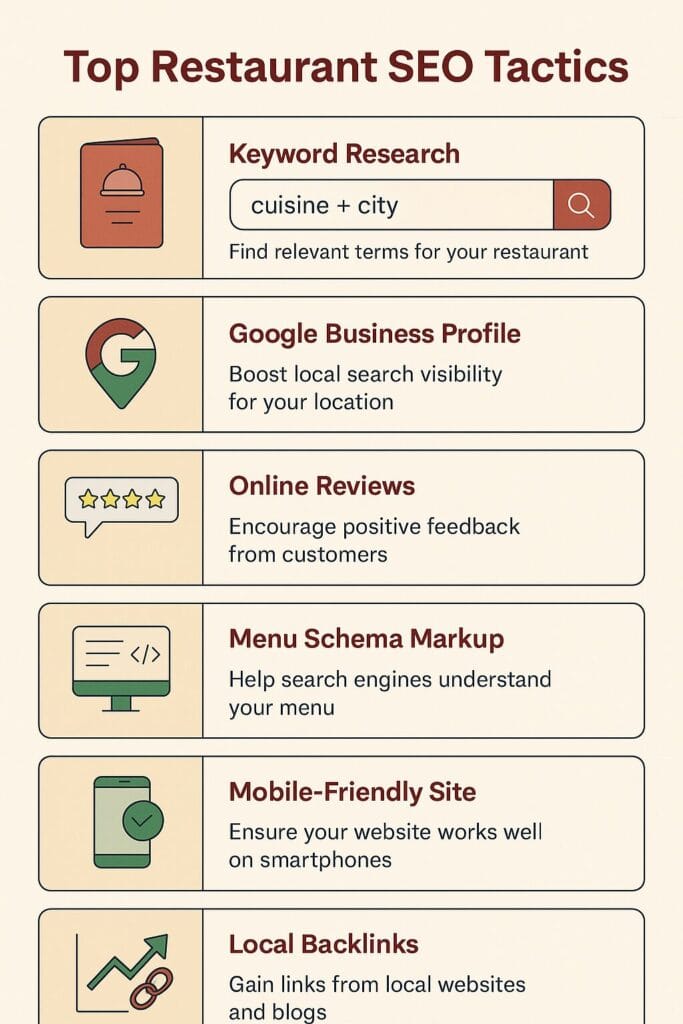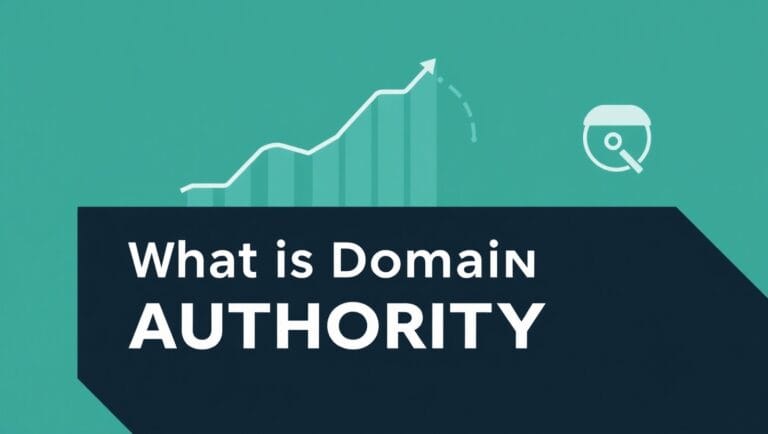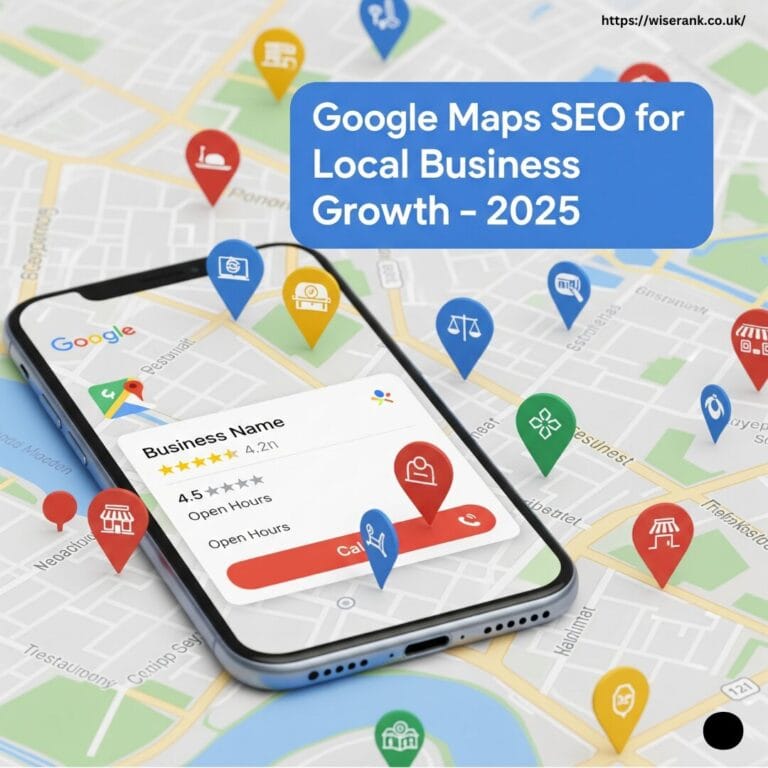In a digital world where diners Google everything from “best pizza near me” to “gluten-free Indian restaurants in [city],” having your restaurant appear at the top of search results is no longer optional — it’s essential.
Search Engine Optimization (SEO) for restaurants helps you attract local customers, fill more tables, and grow your brand presence online — whether you’re a local café, a high-end fine dining venue, or part of a restaurant chain. This complete guide dives deep into how restaurant SEO works, why it’s crucial, and how to execute a winning strategy tailored for the hospitality and food service industry.
Why SEO Matters for Restaurants
People are no longer walking down the street to discover a restaurant — they’re searching for it online. Here’s why SEO is a game changer:
- 75% of diners check online reviews before choosing a restaurant.
- 60% of mobile searches for restaurants result in a same-day visit.
- Restaurants that show up in the “Local Pack” on Google Maps get massively more clicks and calls.

SEO puts your restaurant in front of people when they’re hungry and ready to order or visit.
Local SEO: The Cornerstone for Restaurants
For most restaurants, the goal isn’t national exposure — it’s local visibility. This makes Local SEO the foundation of your strategy.
🔑 Local SEO Priorities:
- Google Business Profile (GBP) optimization
- Consistent Name, Address, Phone (NAP) citations
- Location-specific landing pages
- Earning reviews and responding to them
- Getting listed on local directories like Yelp, TripAdvisor, Zomato, and local food blogs
When optimized properly, these tactics can put your restaurant in the “3-Pack” Google Map results — the golden spot that attracts the majority of clicks.
Keyword Research for Restaurant SEO
Choosing the right keywords means understanding what potential customers are typing into Google.
🍽 Examples of High-Intent Keywords:
| Keyword | Search Intent |
|---|---|
| “Italian restaurant near me” | Find a specific cuisine locally |
| “Best vegan brunch in London” | Quality-driven search |
| “Late-night food delivery in Manchester” | Time-based convenience |
| “Family-friendly restaurants with outdoor seating” | Niche, experience-specific |
Use tools like Google Keyword Planner, Ubersuggest, or Ahrefs to find geo-specific, high-volume keywords related to:
- Your cuisine
- Location
- Unique features (e.g., halal, kid-friendly, gluten-free)
- Meal types (brunch, dinner, takeout)
On-Page SEO for Restaurant Websites
Your website is your digital menu, and it needs to be optimized for both users and search engines.
🧩 Key On-Page SEO Elements:
- Title Tags: Include cuisine, location, and intent (e.g., “Authentic Thai Food in Liverpool | [Your Restaurant Name]”)
- Meta Descriptions: Convince users to click with benefits (e.g., “Book your table at Liverpool’s top-rated Thai restaurant. Dine in, takeout, and delivery available.”)
- Header Tags (H1, H2, etc.): Organize content logically for readers and search engines
- Optimized Images: Use descriptive file names and alt text (e.g.,
wood-fired-pizza-restaurant-london.jpg) - Internal Linking: Connect your menu, gallery, blog, and about pages to enhance crawlability
Technical SEO: Speed, Mobile, and Structure
Restaurant visitors expect fast, mobile-optimized websites. Google expects the same.
⚙️ Technical Essentials:
- Mobile Optimization: 80%+ of food searches are on mobile
- Site Speed: Compress images, use caching, and choose a fast hosting provider
- SSL Certificate: Secure your site with HTTPS
- Crawlability: Use clear URL structures (
/menu/,/about/,/contact/) - 404 Pages & Redirects: Ensure users never hit a dead end
Content Marketing for Restaurants
Create content that speaks to your ideal diners and helps your site rank better.

📄 Examples of SEO-Friendly Content:
- “Top 10 Romantic Restaurants in [City]”
- “What Makes Authentic Turkish Cuisine Special?”
- “Guide to Gluten-Free Dining in [City]”
- Seasonal content like “Easter Brunch Specials” or “Christmas Dinner Menus”
Pro Tip: A restaurant blog that gets traffic can drive new bookings and even rank on Google Discover.
Google Business Profile Optimization
GBP is often the first impression people get of your restaurant.
📍 How to Optimize:
- Upload high-quality images regularly (food, interior, ambiance)
- Use categories like “Vegetarian Restaurant,” “Pizza Delivery,” or “Fine Dining”
- Add your menu using the “Menu” tab or upload a link
- Post updates about offers, events, or new dishes weekly
- Respond to every review — good or bad
Online Reviews and Reputation Management
Online reviews influence rankings and decisions.
💬 Review Tips:
- Encourage happy customers to leave a Google or Yelp review
- Use QR codes on tables or receipts linking to your review page
- Monitor review platforms and respond within 24 hours
- Use positive reviews as social proof on your website
A consistent 4.5+ rating can skyrocket your bookings and keep customers coming back.
Backlinks and Local Citations
Getting mentioned on local blogs, food critics’ websites, and directories builds your authority.
🍴 Where to Get Backlinks:
- Local food bloggers and influencers
- Event sponsorships (e.g., local food festivals)
- PR from newspapers or magazines
- Listings in directories like Yelp, OpenTable, TripAdvisor
Local citations with consistent NAP across all platforms boost Google trust.
Schema Markup for Menus, Reviews, and Locations
Use structured data (schema) to make your listings more eye-catching in search results.
🧠 Must-Have Schema Types:
RestaurantMenuAggregateRatingOpeningHoursSpecificationGeoCoordinates
This helps Google display useful information like menu prices, star ratings, and hours directly in search results.
Measuring SEO Results
Track what matters most for restaurants:
| Metric | Tool |
|---|---|
| Organic traffic | Google Analytics |
| Local pack visibility | Google Search Console & BrightLocal |
| Keyword rankings | Ahrefs, Ubersuggest |
| Call tracking | CallRail or Google Call Reporting |
| Conversion metrics (table bookings, orders) | Google Tag Manager + GA4 |
Why Wiserank Is the Right SEO Partner for You
At Wiserank, we understand that restaurants don’t just need traffic — they need diners. Here’s what makes us different:
- ✅ Industry-Specific SEO: We don’t use generic strategies. Our campaigns are tailored to restaurant SEO, including menu optimization, location-specific targeting, and mobile-first design.
- ✅ Local Domination Tactics: We specialize in Google Maps rankings, ensuring you show up at the top when hungry customers search nearby.
- ✅ Reputation Building: Our team helps you grow and manage online reviews that drive trust and conversions.
- ✅ Fast, Results-Driven Setup: Whether you need SEO for a single restaurant or a multi-location chain, we deliver fast results without shortcuts.
- ✅ Transparent Reporting: Get monthly dashboards with ranking progress, traffic growth, and local visibility improvements.
We don’t just get you clicks. We fill your tables.
Final Thoughts: Make Your Restaurant the First Choice Online
In the highly competitive food service industry, restaurant SEO is not a luxury — it’s a necessity. From ranking on Google Maps to converting online searchers into loyal diners, the right SEO strategy can transform your business.
By implementing strong local SEO, optimizing your Google profile, publishing valuable content, and working with an experienced SEO partner like Wiserank — you’ll position your restaurant as the go-to spot in your area.





